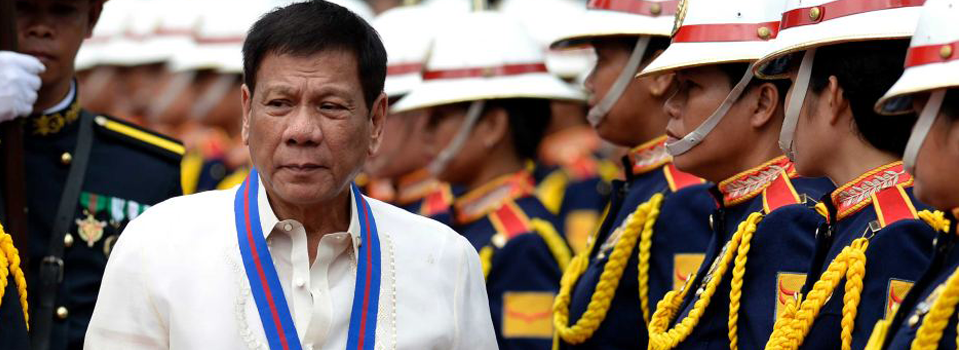NEW OPENING IN US-PHILIPPINE RELATIONS

China’s defiant response to the international judgment against its claims in the South China Sea could draw the Philippines closer to the United States. New Philippine President Rodrigo Duterte will need to work closely with the man or woman whom Americans elect this November in the face of China’s reaction to the ruling.
China has warned rivals against turning the South China Sea into a cradle of war. Only the US has the countervailing power to prevail against China’s demonstrations of might. Not even a coalition of Australia, Japan, Vietnam and India – among countries that are not prepared to countenance the rise of Chinese hegemony – can contain China on its own, without American participation or support.
Chinese intransigence emanates from its history. The Philippines is expected to abide by assertions of Chinese sovereignty because the archipelagic nation belongs to South-east Asia. This is the historic Nanyang region which China had absorbed as a tributary zone into its hierarchical sphere of influence in pre-colonial Asia.
Asia’s colonial period, including the American colonisation of the Philippines, is an era that the continent’s modern nation-states reject. However, they are not prepared for the Westphalian order – based on the sovereign equality of states – to be replaced by a neo-tributary one in which Beijing exercises the Mandate of a post-communist Heaven to recreate its ancient ethnic rule.
For countries such as the Philippines, America remains a bedrock of a rules-based global order in which weaker countries can pursue their economic and political interests without having to contend with the historical baggage of powers which are unable to forget that they held sway in earlier times under different rules.
China is not the only such revisionist power: Japan and India well might come to play that subversive role if China follows the erstwhile Soviet Union in imploding domestically in its pursuit of domination over others.
For the time being, however, China constitutes the main threat to the continuation of the Westphalian order in Asia. The Philippines is among the countries that are aware of just how high the strategic stakes are.
What works to the advantage of the Philippines is that it is an ally of the US. The two countries signed the Enhanced Defence Cooperation Agreement in 2014, a 10-year deal which allows for a greater US military presence in the Philippines, with increased rotating American military personnel and military assistance, broad access to bases, and the construction of new and improved facilities.
When the Philippine Supreme Court voted to uphold the agreement this year, Manila signalled that it finally had overcome the legacy of the acrimonious parting of strategic ways with the US in the 1990s termination of an agreement on its bases in the Philippines.
Back then, observant South-east Asians had pointed out that an American withdrawal from Subic naval base and Clark airbase would contribute to the appearance of a strategic vacuum that other powers would try to fill. China was the most obvious contender for America’s departing role, notwithstanding the common cause that it had made with the US against the Soviet Union in the closing stages of the Cold War era.
The Cassandras were prescient. In the 21/2 decades since then, China has emerged to challenge the entire Indo-Pacific security architecture anchored in American will and power.
Some believe that China’s military assertiveness in the South China Sea is a direct response to America’s pivot – or strategic rebalancing – to the Indo-Pacific. However, that pivot itself was a reply to the increasing clarity of China’s maritime ambitions, which potentially could block international freedom of navigation if that suited Chinese interests.
Certainly, South-east Asia’s economic entanglement with China is growing. One reason for Manila’s muted response to the Law of the Sea Arbitral Tribunal’s ruling is its desire not to antagonise Beijing, which holds the keys to investment in the infrastructural development of the Philippines. President Duterte has made improvements to the country’s archaic infrastructure a centrepiece of his presidential plans.
However, when the demands of security run up against the needs of the economy, countries are obliged to settle for the former. This will be the case with the Philippines if Chinese maritime intransigence exceeds the dividends that Manila can expect realistically from Chinese investment and aid, which suit the donor’s interests at least as much as the recipient’s.
In an effort to balance Manila’s ties with Beijing and Washington, President Duterte proposes to send former president Fidel Ramos to Beijing.
China might make some concessions to the Philippines to show that it is sincere in negotiating with regional countries once they accept its sovereign claims in the South China Sea. Yet, any concession would mean that the Philippines effectively would be relinquishing its rights under the arbitral judgment.
Like other South-east Asian countries, the Philippines does not wish to choose sides between the US and China. However, if forced to do so by Beijing’s diplomatic high-handedness, the natural choice would be Washington.
Beijing would realise that, by having overplayed its hand, it had succeeded merely in resuscitating the enduring bases of the Philippines’ relations with a Pacific power far more powerful than China.

